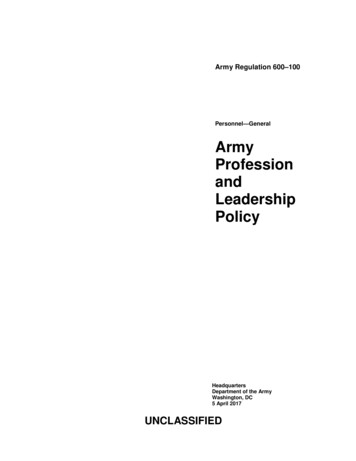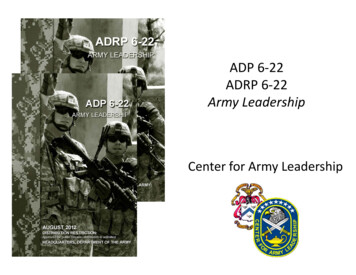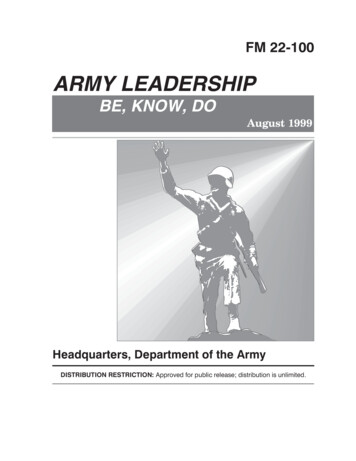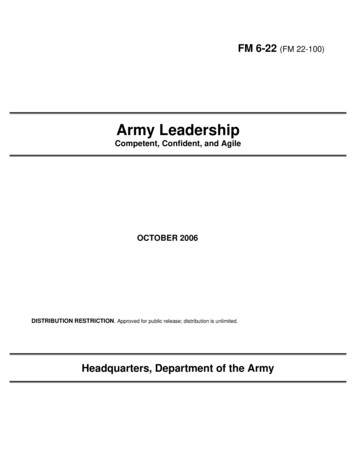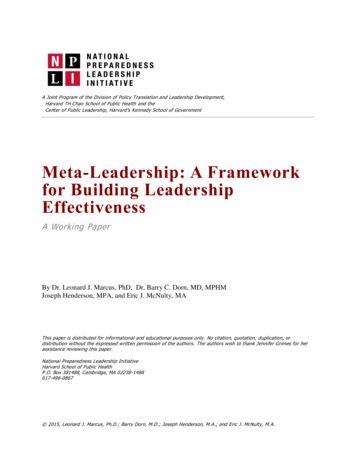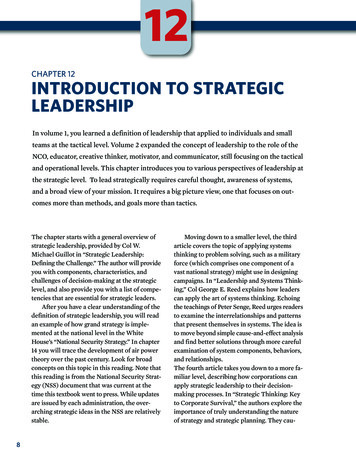
Transcription
Leadership TrackSection1INTRODUCTION TOARMY LEADERSHIPKey Points1What Is Leadership?2The Be, Know, Do Leadership Philosophy3Levels of Army Leadership4Leadership Versus Management5The Cadet Command Leadership Development ProgrameAll my life, both as a soldier and as an educator, I havebeen engaged in a search for a mysterious intangible.All nations seek it constantly because it is the key togreatness — sometimes to survival. That intangible is theelectric and elusive quality known as leadership.GEN Mark Clark
Introduction to Army LeadershipIntroductionAs a junior officer in the US Army, you must develop and exhibit character—acombination of values and attributes that enables you to see what to do, decide to doit, and influence others to follow. You must be competent in the knowledge and skillsrequired to do your job effectively. And you must take the proper action to accomplishyour mission based on what your character tells you is ethically right and appropriate.This philosophy of Be, Know, Do forms the foundation of all that will follow in yourcareer as an officer and leader. The Be, Know, Do philosophy applies to all Soldiers, nomatter what Army branch, rank, background, or gender. SGT Leigh Ann Hester, aNational Guard military police officer, proved this in Iraq and became the first femaleSoldier to win the Silver Star since World War II.Silver Star LeadershipSGT Leigh Ann Hester of the 617th Military Police Company, a National Guardunit out of Richmond, Ky., received the Silver Star, along with two other membersof her unit, for their actions during an enemy ambush on their convoy. Hester’ssquad was shadowing a supply convoy [in March 2005] when anti-Iraqi fightersambushed the convoy. The squad moved to the side of the road, flanking theinsurgents and cutting off their escape route. Hester led her team through the“kill zone” and into a flanking position, where she assaulted a trench line withgrenades and M203 grenade-launcher rounds. She and Staff SGT Timothy Nein,her squad leader, then cleared two trenches, at which time she killed threeinsurgents with her rifle.When the fight was over, 27 insurgents were dead, six were wounded, andone was captured. Being the first female soldier since World War II to receive themedal is significant to Hester. But, she said, she doesn’t dwell on the fact.“It really doesn’t have anything to do with being a female,” she said. “It’sabout the duties I performed that day as a soldier.” Hester, who has been in theNational Guard since April 2001, said she didn’t have time to be scared whenthe fight started, and she didn’t realize the impact of what had happened untilmuch later. 3
4 SECTION 1Figure 1.1 The Army’s Be, Know, Do Leadership PhilosophyWhat Is Leadership?leadershipinfluencing people—byproviding purpose,direction, andmotivation—whileoperating to accomplishthe mission andimproving theorganizationLeadership is the process of influencing people by providing them with purpose, direction,and motivation while you are operating to accomplish a mission and improve theorganization.An Army leader is anyone who, by virtue of assumed role or assigned responsibility,inspires and influences people to accomplish organizational goals. Army leaders motivatepeople both inside and outside the chain of command to pursue actions, focus thinking,and shape decisions for the greater good of the organization.Being a leader is a lot more complex than just giving orders. Your influence on otherscan take many forms. Your words and your deeds, the values you talk about, the exampleyou set, every action you take—on or off duty—are all part of your influence on others.Providing Purpose and Visioncommandpossession and exerciseof the authority tocommand, a specificand legal positionunique to the military—the legal and moralresponsibilities ofcommanders exceedthose of any otherleader of similar positionor authorityBy providing purpose, you enable your Soldiers to see the underlying rationale for a mission;you provide them the reason to act in order to achieve a desired outcome. Leaders shouldprovide clear purpose for their followers; they do that in a variety of ways. They can usedirect means through requests or orders. As time goes on, your subordinates will noticethat you communicate in a consistent style of command and decision making that buildstheir trust and confidence. Your Soldiers will eventually be able to read a situation andanticipate your intentions and actions. This trust in turn leads to a cohesive, integrated,and effective unit.Vision is another way that leaders provide purpose. Vision refers to an organizationalpurpose that may be broader or have less immediate consequences than other purposestatements. Higher-level leaders carefully consider how to communicate their vision.
Introduction to Army Leadership 5Providing DirectionWhen giving direction, you make clear how you want your Soldiers to accomplish a mission.You prioritize tasks, assign responsibility for completing them (delegating appropriateauthority), and make sure subordinates understand the Army standard for the tasks. Youdecide how to accomplish a mission with the available people, time, and resources. It isyour subordinates’ job to carry out your orders. But to do that, they need clear direction.Give just enough direction to allow Soldiers to use their initiative, abilities, andimagination—and they will surprise you with the results.Providing MotivationMotivation is the will to accomplish a task. By learning about your Soldiers and theircapabilities, you will soon be able to gear the team to the mission. Once you have givenan order, don’t micromanage the process—allow your Soldiers to do their jobs to the bestof their abilities. When they succeed, praise them. When they fail, give them credit for theattempt, and coach them on how to improve. Remember that it takes more than just wordsto motivate. The example you set is at least as important as what you say and how wellyou manage the work. Stay involved and motivate yourself to attain the best mission result,and your enthusiasm will carry over. A leader’s role in motivation is to understand theneeds and desires of others, to align and elevate individual drives into team goals, and toinfluence others and accomplish those larger aims. You’ll find that some people have highlevels of internal motivation to finish a job, while others need more reassurance andfeedback. Motivation spurs initiative when something needs to be accomplished.The Be, Know, Do Leadership PhilosophyThe characteristics of an effective Army leader make up the Be, Know, Do philosophy. Asyou have already seen, leadership involves influencing others to take appropriate action.But becoming a leader involves much more. Embracing a leadership role involves developingall aspects of yourself: your character, your competence, and your actions. You learn to leadwell by adopting the Army Values, learning military skills, and practicing leadership actions.Only by this self-development will you become a confident and competent leader ofcharacter. Figure 1.1 will help you correlate the Be, Know, Do philosophy of Army leadershipwith the leader attributes and core leader competencies.TA B L E 1 . 1LLoyaltyDRSHIPDutyRespectSelfless ServiceHonorIntegrityPersonal CourageBe, Know, Dothe key characteristics ofan Army leader thatsummarize the leaderattributes and coreleader competenciesThe Seven Key Army ValuesBear true faith and allegiance to the US Constitution, the Army, your unit, andother SoldiersFulfill your obligationsTreat people as they should be treatedPut the welfare of the nation, the Army, and subordinates before your ownLive up to all the Army ValuesDo what is right—legally and morallyFace fear, danger, or adversity (physical or moral)
6 SECTION 1Attributes—What an Army Leader IsBE: Who You Are—A Leader of Character and a Leader With PresenceArmy leadership begins with what the leader must Be—the values and attributes that shapecharacter. It may be helpful to think of these as internal and defining qualities you possessall the time. As defining qualities, they make up a leader’s identity. Your character is whoyou are and informs everything you do and ask others to do. You demonstrate yourcommitment to character and to a leadership role in the Army by adopting and living theseven Army Values and the leader attributes. These values form the foundation of yourcharacter as a military officer and will guide you in your career. By living the Army Values,you will teach your subordinates by example and help them develop leader attributes.TA B L E 1 . 2 aThe Leader Attributes1. A Leader of Character (Identity)Factors internal and central to a leader, that which makes up an individual’s coreArmy Values Values are the principles, standards, or qualities considered essential for successful leaders Values are fundamental to help people discern right from wrong in any situation The Army has set seven values that must be developed in all Army individuals: loyalty, duty, respect,selfless service, honor, integrity, and personal courage.Empathy The propensity to experience something from another person’s point of view The ability to identify with and enter into another person’s feelings and emotions The desire to care for and take care of Soldiers and others.Warrior Ethos The shared sentiment internal to Soldiers that represents the spirit of the profession of arms.2. A Leader With PresenceHow a leader is perceived by others based on the leader’s outward appearance, demeanor, actions,and wordsMilitary Bearing Possessing a commanding presence Projecting a professional image of authority.Physically Fit Having sound health, strength, and endurance that support one’s emotional health and conceptualability under prolonged stress.Composed Demonstrating composure and an outward calm through steady control over one’s emotions.Confident Projecting self-confidence and certainty in the unit’s ability to succeed in whatever it does.Resilient Showing a tendency to recover quickly from setbacks, shock, injuries, adversity, and stress whilemaintaining a mission and organizational focus.
Introduction to Army LeadershipTA B L E 1 . 2 b The Leader Attributes (continued)3. A Leader With Intellectual CapacityThe mental resources or tendencies that shape a leader’s conceptual abilities and impact effectivenessMental Agility Flexibility of mind The tendency to anticipate or adapt to uncertain or changing situations; to think through secondand-third-order effects when current decisions or actions are not producing the desired effects The ability to break out of mental “sets” or habitual thought patterns; to improvise when faced withconceptual impasses The ability to quickly apply multiple perspectives and approaches to assessment, conceptualization,and evaluation.Sound Judgment The capacity to assess situations or circumstances shrewdly and to draw sound conclusions The tendency to form sound opinions and make sensible decisions and reliable guesses The ability to make sound decisions when all facts are not available.Innovation The tendency to introduce new ideas when the opportunity exists or in the face of challengingcircumstances Creativity in producing ideas and objects that are both novel or original and worthwhile orappropriate.Interpersonal Tact The capability to understand interactions with others Being aware of how others see you and sensing how to interact with them effectively Consciousness of character and motives of others and how that affects interacting with them.Domain Knowledge Possessing facts, beliefs, and logical assumptions in relevant areas Technical knowledge—specialized information associated with a particular function or system Tactical knowledge—understanding military tactics related to securing a designated objectivethrough military means Joint knowledge—understanding joint organizations, their procedures, and their roles in nationaldefense Cultural and geopolitical knowledge—understanding cultural, geographic, and political differencesand sensitivities.KNOW: Skills You Have Mastered—A Leader With Intellectual CapacityCompetence in soldiering skills—what you Know—is as important as good character inyour growth as an Army leader. Without it, your command will lack substance. To asksubordinates to perform to standard, you must first master the standard yourself. Youmust master five types of Army leadership attributes and skills in your training: Mental agility—having flexibility of mind, a tendency to anticipate or adapt touncertain or changing situations Sound judgment—having a capacity to assess situations or circumstances shrewdlyand to draw feasible conclusions7
8 SECTION 1eCritical ThinkingDiscuss the attributes of leadership SGT Hester demonstrated during the ambushin Iraq (see Page 3). Innovation—the ability to introduce something new for the first time when neededor an opportunity exists Interpersonal tact—interacting with others and accepting the character, reactions,and motives of oneself and others Domain knowledge—possessing facts, beliefs, and logical assumptions and anunderstanding of military tactics related to securing a designated objective throughmilitary means.A natural part of an Army officer’s career is the opportunity for advancement andpromotion. As you advance in rank and responsibility, you will face many new challenges.Having an understanding of and competence in basic Army skills will give you the abilityto tackle these new challenges with confidence.Core Leader Competencies—What an Army Leader DoesDO: How You Carry out Your Decisions—Leads, Develops, and Achievesesprit de corpsa shared sense ofcomradeship anddevotion to the causeamong members of agroup, team, or unitAs you have already seen, leadership takes place in action. What you Do is every bit asimportant as the Be and Know aspects of your Army leadership philosophy. While characterand knowledge are necessary, by themselves they are not enough. Leaders cannot be effectiveuntil they apply what they know. What leaders Do, or leader actions, is directly related tothe influence they have on others and on what is done.While the process of influencing others may seem a little vague or intangible at first,the concept becomes concrete when coupled with operating actions. Operating actionsare those you take to achieve the short-term goal of accomplishing a mission, such asholding a briefing or conducting a drill. While all direct leaders perform operating actions,the type and scope of such actions become more complex as your rank and level ofresponsibility change. Moreover, it is a natural part of humans’ competitive drive to wantto get better and better at what they do. Leaders—in seeking to build morale, unit espritde corps, and performance—strive to improve the Soldiers, facilities, equipment, training,and resources under their command. Nothing speaks more clearly to your subordinatesabout your commitment to excellence and improvement than your ongoing assessmentof the unit’s performance and your leading the way toward improvement. Your investmentof time, effort, and interest in your subordinates’ improved performance will pay dividendsin building trust and esprit de corps.
Introduction to Army LeadershipTA B L E 1 . 3 9The Core Leadership CompetenciesLeadsLeading is all about influencing others. Leaders and commanders set goals and establish avision, and then must motivate or influence others to pursue the goals. Leaders influenceothers in one of two ways. Either the leader and followers communicate directly, or theleader provides an example through everyday actions. The key to effective communication isto come to a common or shared understanding.DevelopsDeveloping the organization involves three competencies: creating a positive environment inwhich the organization can flourish, preparing oneself, and developing other leaders. Theenvironment is shaped by leaders taking actions to foster working together, encouraginginitiative and personal acknowledgment of responsibility, setting and maintaining realisticexpectations, and demonstrating care for people—a leader’s No. 1 resource.AchievesAchieving is the third competency. Ultimately, leaders exist to accomplish those endeavorsthat the Army has prescribed for them. Getting results, accomplishing the mission, andfulfilling goals and objectives are all ways to say that leaders exist at the discretion of theorganization to achieve something of value. Leaders get results through the influence theyprovide in direction and priorities. They develop and execute plans and must consistentlyaccomplish goals to a high ethical standard.Levels of Army LeadershipArmy leadership positions divide into three levels—direct, organizational, and strategic.The leadership level involves a number of factors, including: Span of controlHeadquarters levelExtent of the influence of the leader holding the positionSize of the unit or organizationType of operations the unit conductsFigure 1.2 Army Leadership LevelsOath of Office Takenby CommissionedOfficers in the USArmyI [full name], havingbeen appointed a [rank]in the United StatesArmy, do solemnly swear(or affirm) that I willsupport and defend theConstitution of theUnited States against allenemies, foreign anddomestic; that I will beartrue faith and allegianceto the same; that I takethis obligation freely,without any mentalreservation or purpose ofevasion, and that I willwell and faithfullydischarge the duties ofthe office upon which Iam about to enter. Sohelp me God.Leader rank or grademay not automaticallyindicate the position’sleadership level, which iswhy Figure 1.2 containsno ranks.
10 SECTION 1 Number of people assigned The unit’s long-term mission or how far in advance it develops plans.Direct LeadershipDirect leadership is face-to-face, first-line leadership. Subordinates of direct leaders seethem all the time at the team, squad, section, platoon, company, battery, squadron, andbattalion levels. The direct leader may command anywhere from a handful to severalhundred people. Direct leaders influence their subordinates one-on-one, but may still guidethe organization through subordinate officers and noncommissioned officers (NCOs).Direct leaders quickly see what works, what doesn’t work, and how to address problems.Organizational LeadershipOrganizational leaders command several hundred to several thousand people. Theircommand is indirect, generally through more levels of subordinates. This “chain ofcommand” sometimes makes it difficult for them to see results. Organizational leadersusually employ staffs of subordinate officers to help manage their organizations’ resources.Organizational leaders are responsible for establishing policy and the organization’s workingclimate. Their skills are the same as those of direct leaders, but they cope with morecomplexity, more people, greater uncertainty, and a greater number of unintendedconsequences. They have little face-to-face contact with the rank-and-file Soldier andcommand at the brigade through corps levels. Typically, their focus is on planning andmissions in the next two to 10 years.Strategic LeadershipStrategic leaders include military and Department of the Army (DA) civilian leaders fromthe major command level through the Department of Defense leadership. Strategic leadersare responsible for large organizations and influence several thousand to hundreds ofthousands of people. They establish force size and structure, allocate resources,communicate strategic vision, and prepare their commands for their future roles. Strategicleaders consider the total environment in which the Army functions. They may take intoaccount such things as congressional hearings, Army budgetary constraints, new-systemsacquisition, civilian programs, research, development, and interservice cooperation.Leadership Versus ManagementThe Art of DelegatingDownwardThe challenge ofcommand
character.Figure 1.1 will help you correlate the Be,Know,Do philosophy of Army leadership with the leader attributesand core leader competencies. Introduction to Army Leadership 5 Be, Know, Do the key characteristics of an Army leader that summarize the leader attributes and core leader competencies




